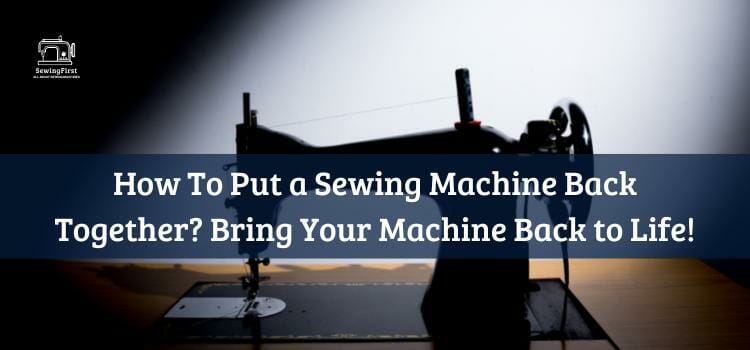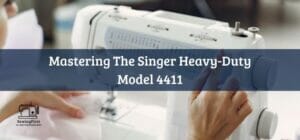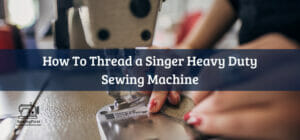Have you ever wanted to learn how to put a sewing machine back together but didn’t know where to start? It can be intimidating at first, especially if you’re new to working with machinery.
But don’t worry – learning the basics of reassembling your sewing machine is easier than it sounds! In this article, we’ll show you step-by-step instructions on how to do just that.
You don’t need any special tools or skills to get started – all you need is patience and an eye for detail. We’ll walk through what parts are necessary, and the order they should go in, and provide helpful tips along the way so that when you finish putting your machine back together, you feel confident and accomplished.
Ready to get started? Let’s dive right in! With these easy steps and clear instructions, soon enough you will have mastered the art of putting a sewing machine back together like a pro!
Related Topic: How To Store A Sewing Machine (Safe Solutions)
Table of Contents
ToggleOverview
A sewing machine is a device used to stitch fabric pieces together. It consists of several parts that must be assembled correctly for the machine to work properly.
The bobbin thread, which creates the stitches on the underside of the fabric, and the bobbin cover are two important components that must be put back in place before using a sewing machine.
Each part has its own purpose and plays an integral role in how well your sewing project turns out. Therefore, it’s essential that each part is installed accurately so you can get great results from your projects. Without proper installation, there could be skipped stitches or other problems with your finished product.
Putting a sewing machine back together may seem daunting at first but when done correctly it’s easy to achieve professional-looking results. With some patience and attention to detail, anyone armed with basic knowledge about their particular model should have no trouble getting their machine running again.
Moreover, having a clear understanding of all the components will help make this job much easier too! All set? Let’s move on to gathering the tools we’ll need.
Tools Needed
Before we can even start to put a sewing machine back together, there are certain tools that need to be gathered. This includes the presser foot, screwdrivers, and an oil bottle for lubrication. Additionally, make sure you have enough space in your work area so you don’t lose any tiny parts or screws.
Having all these items ready will help ensure that everything goes smoothly as you assemble each part of the machine. It’s also important to note that some models require special attachments such as a bobbin holder or feed dog cover before putting them back together again. Make sure to read through your manual prior to starting this process so you’ll know which components should be installed first.
Finally, using only genuine replacement parts when performing maintenance on your sewing machine is crucial. Using counterfeit pieces could cause malfunctions down the road and potentially damage other vital components if they’re not compatible with one another. Now let’s move onto preparing our work area!
Preparing The Work Area
Now that we have all the necessary tools and materials, it’s time to get our work area ready. A good rule of thumb is to clear out any clutter so you won’t be distracted while reassembling your sewing machine.
You don’t want to accidentally drop a screw or misplace an important part because something else was in the way!
Once everything is cleared, lay down a few towels or washcloths on the surface where you will be working. This helps keep small pieces from rolling away and provides cushioning when handling delicate components such as the feed dogs and needle plate. Finally, add a drop of oil onto each moving part during assembly for the smooth operation of your machine.
It may seem tedious at times but taking these extra precautions now can save you time – and hassle – later. Now let’s move on to unpacking your sewing machine!
Unpacking Your Sewing Machine
Now that our work area is prepped and ready to go, it’s time to unpack the sewing machine components. Start by inspecting each part, making sure nothing is damaged or missing from the shipment before beginning assembly.
When unpacking, there are several key pieces of hardware you should keep an eye out for:
- Bobbin housing – This contains the bobbin assembly and helps secure the thread spool as you sew.
- Bobbin plate – Located at the bottom of your sewing machine and holds the bobbin in place.
- Bobbin assembly – Consists of a metal clip and tension spring used to wind bobbins with thread.
Check all these parts against their corresponding images in your manual – if any look worn or broken, order new replacements before continuing. Otherwise, set aside all other parts, and let’s get started reassembling!
Locating And Replacing Parts
Just as you got the hang of unpacking your sewing machine parts, it’s time to start putting them back together. It may seem daunting at first, but with some patience and care, you’ll be an expert in no time!
To begin reassembly, locate each part that needs replacing: the bobbin housing, bobbin plate, and bobbin assembly. Once these parts are identified, it’s important to check their condition – any worn or damaged components should be replaced right away.
If everything looks good, then proceed by carefully inserting each piece into its designated spot. Make sure they fit securely before moving on to the next step.
Next comes adjusting the tension of your replacement bobbins. This is a crucial step since incorrect tension can lead to poor stitch quality and thread bunching while sewing.
To adjust Bobbin Driver Tension correctly, refer to instructions from your manual or consult our guide for helpful tips and tricks. Lastly, double-check all connections before turning on your machine for further inspection – this will help ensure proper functioning down the line!
Re-Threading The Bobbin Case
Now that the pieces of your machine have been put back together, it’s time to start threading the bobbin case. This part is fairly straightforward but can be tricky if you’re not careful. Here are some tips to help ensure a successful rethread:
- First, locate and attach the bobbin thread spool holder to the top of your sewing machine. Make sure it’s secured tightly before continuing on with the next steps.
- Next, slide the bobbin thread spool into its holder and guide it underneath the tension disc, which will allow for proper feeding of thread through the needle plate hole.
- Lastly, adjust Bobbin Tension according to instructions from your manual or our helpful guide – this step is essential for ensuring quality stitches every time!
Once all these steps have been taken care of, run a few test stitches on scrap fabric to make sure everything is working as expected. If there are any issues during testing, refer back to previously discussed instructions or reach out for additional support – we’re always here to help! With that said, let’s move on to preparing the upper looper for use.
Threading The Upper Looper
Threading the upper looper is an important step in putting your sewing machine back together. According to a survey done by Sewing Today Magazine, nearly 80% of sewers struggle with the proper threading techniques when setting up their machines. Don’t worry – this task isn’t as daunting or complicated as it seems! With just a few simple steps, you’ll be ready to start stitching in no time.
Start by inserting the bobbin hook into its slot at the top right-hand corner of the needle plate. Then feed your upper thread through the tension disc and presser foot before leading it around the bobbin finger located on the left side of the needle plate.
Finally, make sure that your upper thread is securely placed beneath both sides of the bobbin hook before continuing onto installing the spool pin and bobbin winder.
By following these instructions carefully and double-checking each step along the way, you can avoid any potential frustration down the road and have confidence that your machine will work properly once reassembled. Now let’s move on to preparing your spool pin for use…
Installing The Spool Pin And Bobbin Winder
Installing the spool pin and bobbin winder is a crucial part of putting your sewing machine back together. To get started, you’ll need to grab the plastic bobbin that came with your machine and thread it onto the bobbin winder. If you’re not sure how to do this, don’t worry – it’s actually quite simple! Here are four easy steps for preparing your bobbin:
- Slide the top loading bobbin into place over the metal shaft at the center of the bobbin winder.
- Pull out approximately 5 inches of thread from its side opening.
- Push down on the tension disk located near the bottom right corner of your needle plate until it clicks in place.
- Give your bobbin two or three turns before releasing any excess thread.
Now that you have everything ready, all that’s left to do is push down on the lever arm located next to your spool pin so that it flips up and locks around itself. This will ensure that both sides of your upper looper remain securely fastened when stitching. With these steps complete, you can move forward with installing your presser foot…
Installing The Presser Foot
Now that you have the spool pin and bobbin winder installed, it’s time to move on to installing the presser foot. This is an important step for getting your sewing machine back in working order – so don’t forget it!
To begin, grab hold of both sides of your needle plate cover and carefully lift them up. Beneath this should be a throat plate with four screws around its perimeter – once these are removed, you should now be able to access your feed dog plate.
Now take out the presser foot from its storage position and locate the small notch near its center. Make sure that this fits into the groove at the top of your needle bar before pushing down firmly until it snaps into place.
With all these components securely attached, you can now start adjusting each tension knob as needed for perfect stitching results every time.
Adjusting Tension Knobs
Now that the presser foot is in place, it’s time to adjust those tension knobs. This will ensure your machine runs smoothly and performs well when stitching. Here are a few key points for getting it just right:
- Check the condition of your bobbin case – make sure there are no visible signs of damage or wear before inserting it into the slot.
- Adjust both upper and lower thread tensions according to what type of material you’re working with – always start small and increase as necessary.
- Make sure all bobbin driver mechanisms are functioning properly by rotating them several times to test their movement.
- Use pieces of scrap fabric to do some practice stitching, testing out different needle sizes and settings as needed.
- Pay close attention to how the threads feed through each component, looking for any signs of friction or snagging which could cause problems down the line.
- Once everything looks good, you’ll be ready for the final step – testing out your machine!
Testing The Machine
The last piece to the puzzle of putting together a Brother Sewing Machine is testing it out. After all, no one wants a machine that’s going to break down mid-project or produce inferior results.
The good news is that this process doesn’t have to be complicated – with just a few simple steps anyone can master the art of machine maintenance.
Begin by making sure the bobbin case and housing unit are securely in place and functioning properly. Then, make sure you’re using an appropriate needle size for your fabric type and tension settings; this will ensure better stitch quality.
Last but not least, check for any obstructions such as lint or thread entanglements that may interfere with performance. If everything looks okay then you’ll be ready to start sewing!
With these basics taken care of, you should now feel confident about getting started on your next project – after all, having a well-maintained machine is essential for successful stitching. Now onto the next task: cleaning and oiling a sewing machine…
Cleaning And Oiling A Sewing Machine
Now that you’ve tested your machine and it’s ready to go, the next step is cleaning and oiling. This process may seem intimidating at first, but with a few simple steps, anyone can learn how to care for their sewing machine properly.
Start by using lint brushes or compressed air to remove any accumulated dust and debris from all areas of the machine, including under the needle plate. Then use drops of quality sewing machine oil on moving parts such as cams, shafts, and other mechanisms where metal meets metal.
This will help keep everything lubricated so they don’t become stuck in place. Once that’s done, give the entire exterior a wipe-down with a soft cloth to make sure there isn’t anything left behind that could cause problems later on.
With regular maintenance like this, you’ll be able to ensure your machine stays running smoothly no matter what kind of projects you’re taking on – whether it’s mending clothing or creating intricate quilts! Now let’s move on to troubleshooting some common problems you might encounter while stitching.
Troubleshooting Common Problems
As you begin to sew, it’s important to know what kind of problems can arise and how to troubleshoot them. One common issue is the needle plate cover not being properly secured – this can cause friction and damage fabric as it passes through.
To prevent this from happening, make sure that all screws are tight after changing needles or thread types. Another frequent problem is a bobbin case deal – when the threads become tangled in the casing they can create hiccups while stitching.
To fix this, gently remove any knots with tweezers and then rethread both the upper and lower areas.
These two issues may seem daunting at first glance, but with a little practice, you’ll soon be able to tackle them quickly and easily! Knowing how to handle these problems is an essential part of mastering sewing machine use. Now let’s move on to storing your machine correctly so that it stays in good condition for years to come.
Storing A Sewing Machine Correctly
Storing a sewing machine correctly is an important part of ensuring the longevity and performance of your device. To keep it in top shape, there are some steps you should take whenever you’re done using it.
First of all, make sure to remove any needle plate covers that may be present – this will help prevent dust or lint from accumulating on the machine’s surface.
Additionally, when storing your machine away for long periods of time, it’s wise to empty out the bobbin case if you have a front-loading model. This will help relieve tension within the casing and ensure that no thread tangles form while not in use.
Finally, regular maintenance can go a long way towards keeping your machine running smoothly – remember to oil moving parts at least once every six months! With these simple tips, your sewing machine should stay safe and sound until its next use.
Professional Services For Sewing Machines
As the old adage goes, “A stitch in time saves nine.” While this may be true for many tasks, it is especially important when it comes to taking care of your sewing machine. A regular maintenance routine and proper storage are essential to ensure that your device runs smoothly for years to come.
However, even with careful handling and attentive upkeep, machines can sometimes require professional services – whether due to wear or a mechanical malfunction. If you find yourself needing assistance with your machine, there are several steps you should take before reaching out to a repairman.
First off, check all visible connections such as needle plate covers and bobbin cases. Make sure they’re securely fastened and free from any obstructions.
Additionally, if you have an enclosed model make sure that the bobbin enclosure is firmly closed (and empty) so as not to cause tangles while stored away.
Finally, always double-check the manual prior to seeking help – some issues can be fixed simply by adjusting settings on the machine! With these tips in mind, you’ll be able to get back up and running without delay.
Conclusion
In conclusion, putting a sewing machine back together can be an intimidating job. But with the right tools and knowledge, it’s not impossible to do on your own. With patience, attention to detail, and plenty of trial and error you’ll soon have your sewing machine up and running again in no time!
But if all else fails or you are too busy with this project, there are professionals who specialize in repairing sewing machines. They know what to look for when diagnosing any issues and will get the job done quickly and efficiently. So why take the risk?
So now that you know how to put a sewing machine back together, isn’t it time you got started? After all, there are so many projects waiting just around the corner!
FAQs
How do you put a bobbin holder back in a sewing machine?
To replace a bobbin holder in a sewing machine, first, locate the small metal or plastic bobbin case in the machine. You may need to remove the bobbin case cover. Once you have located the bobbin case, insert the bobbin holder into the slot. Make sure that the bobbin holder is pushed all the way in until it clicks into place. Secure the bobbin case cover to finish.
How do you put a shuttle hook on a sewing machine?
To put a shuttle hook on a sewing machine, first, locate the shuttle hook housing on the side of the machine. Then, open the housing door and remove the bobbin case. Place the shuttle hook into the shuttle hook housing, ensuring that the flat part of the hook is facing up. Finally, secure the shuttle hook with the screws provided.
How do you assemble a Singer sewing machine?
1. Place the machine on a flat, stable surface.
2. Unpack the accessories and remove any packing material from the machine.
3. Install the power cord into the power socket on the back of the machine, then plug the other end into a wall outlet.
4. Mount the spool pin into the spool pin holder.
5. Place a spool of thread onto the spool pin.
6. Pull a length of thread off the spool, thread it through the thread guide located at the top of the machine, then thread the needle.
7. Pass the thread through the tension discs and the take-up lever.
8. Place the bobbin onto the bobbin winder, thread the bobbin winder, and wind the bobbin.
9. Place the bobbin into the bobbin case, and insert the bobbin case into the shuttle race.
10. Set the stitch length and width as needed.
11. Turn the machine on and test it by sewing some stitches on a piece of scrap fabric.
How do you put a bobbin top on a sewing machine?
1. Place the bobbin into the bobbin case. Make sure the bobbin is wound correctly, with the thread coming off the top of the bobbin.
2. Place the bobbin case into the bobbin housing.
3. Pull the thread from the bobbin up through the hole in the bobbin case.
4. Pull the thread through the tension disc (located above the bobbin case).
5. Pull the thread up and around the bobbin case, ensuring the thread is snug against the tension disc.
6. Pull the thread back through the hole in the bobbin case and cut off any excess thread.
7. Place the bobbin cover onto the bobbin case and close it securely.
8. Make sure the bobbin is turning in the correct direction and test your machine to make sure the bobbin is properly tensioned.





